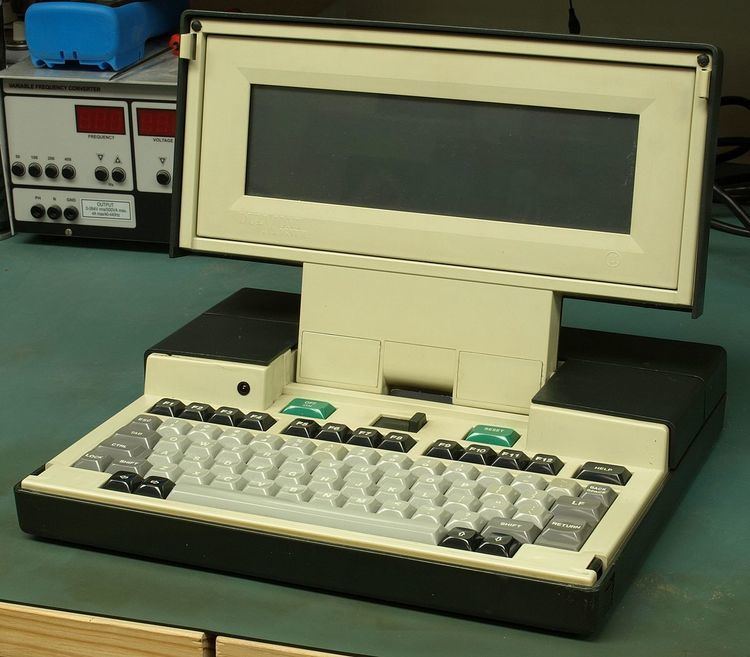Also known as Kookaburra | Developer Dulmison Pty Ltd Discontinued 1986 (1986) | |
 | ||
Manufacturer Dulmont Electronic Systems Pty Ltd Release date September 26, 1983 (1983-09-26) (Australia)1983 (International) | ||
The Dulmont Magnum was an early laptop computer designed and marketed by Dulmison Pty Ltd in Australia in the early 1980s. The Magnum was also known internationally as the Kookaburra, and was sold from 1982 to 1986. The company found itself undercapitalized as it sought to enter the international market and faced increased competition from other laptops. It was taken over twice, with Dulmont eventually taken over by Time Office Computers (Manufacturing) Pty. Ltd, who marketed the Magnum internationally in 16 and 25 line LCD versions, and also introduced the brandname Kookaburra to emphasize its Australian origins.
The Magnum was one of the first computers to use the 16-bit Intel 80186 processor, and was sold in versions with 96K to 256K of RAM, and inbuilt LCD screens from 8x80 to 25x80 characters. It had a word processor, spreadsheet, telecommunications, file manager, and appointment programs burned into ROM. It also featured dual 128K ROM cartridge slots, which could be used for optional software including BASIC or assembler programming support, as well as serial and parallel modem and printer ports. The 1982 to 1983 prerelease and initial release versions included an 8x80 character LCD screen, whilst the 1984 to 1985 international release had a 16x80 display, and the final 1985-6 version had a 25x80 display and for international marketing purposes was given the new name "Kookaburra". Earlier versions were able to be upgraded to the larger displays, and a dual 5.25" floppy drive and memory expansion box provided access to up to 256KB of dynamic RAM. Applications were stored in ROM (A:) and also supported removable modules in expansion slots (B: and C:) that could be custom programmed EPROM or standard word processing and spreadsheet applications. However, the Magnum had no nonvolatile memory, but could suspend and retain memory in RAM, including a RAM Disk (D:). A separate expansion box provided dual 5.25" floppy or 10MB hard disk storage.
The Magnum was arguably the world's first laptop computer, and was to be enabled by a custom power management integrated circuit that was to be developed in the VLSI and Systems Technology Laboratory at the University of New South Wales (UNSW) over 4 months in early 1982 by Graham Hellestrand. However the ~10,000 transistor, 5μ nMOS technology chip never saw the light of day. Terry Crews was the initial Engineering Manager and contracted Barry Wilkinson to design the hardware based on discrete components as he had doubts about the custom chip. The form factor and cosmetic design was developed first and this then dictated the physical dimensions of the hardware. This was in contrast to the usual method of encasing the electronics as the last process and their subsequent bulkier designs.
John Blair led the engineering team. Terry Crews became Marketing Manager once the Magnum went into production and the engineering role was taken over by Chris Todter. Terry Crews traveled the world showcasing the product. It attracted substantial interest and some large orders. The Magnum was marketed in Australia from 1983 to early 1986, thus being developed and launched prior to the development of the Grid Compass.
The Magnum was launched publicly at the 10th Australian Computer Conference on same day that Australia won the America's Cup. in September 1983.
The Magnum laptop computer is similar to the Hewlett Packard HP 110 and the Sharp PC-5000. It is the only Australian produced laptop personal computer, but did not survive long on the international market once industry players like HP, Sharp and Sanyo entered the market. One key disadvantage of both the Dulmont Magnum [Kookaburra] and the Grid Compass is that they were developed prior to the IBM PC and were never upgraded to full IBM compatibility, using an early version of MS-DOS (latest version used was 2.11). A second disadvantage of the Magnum was the lack of integral permanent storage other than the ROM/EPROM that was available through the module cartridge slots, or the separate expansion box. In particular, its soon-to-arrive competitors (including the Grid Compass) made use of the new Bubble memory technology to provide non-volatile memory.
In 1985, the Magnum retailed for 2995 AU$ (today $7336.20) for a 96K model, or 4100 AU$ (today $10042.88) for a 256K model..
